
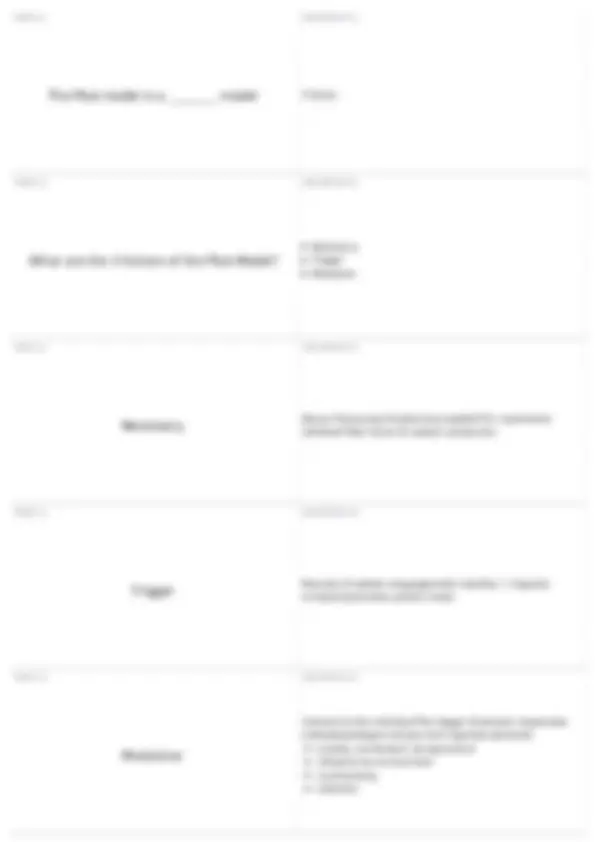
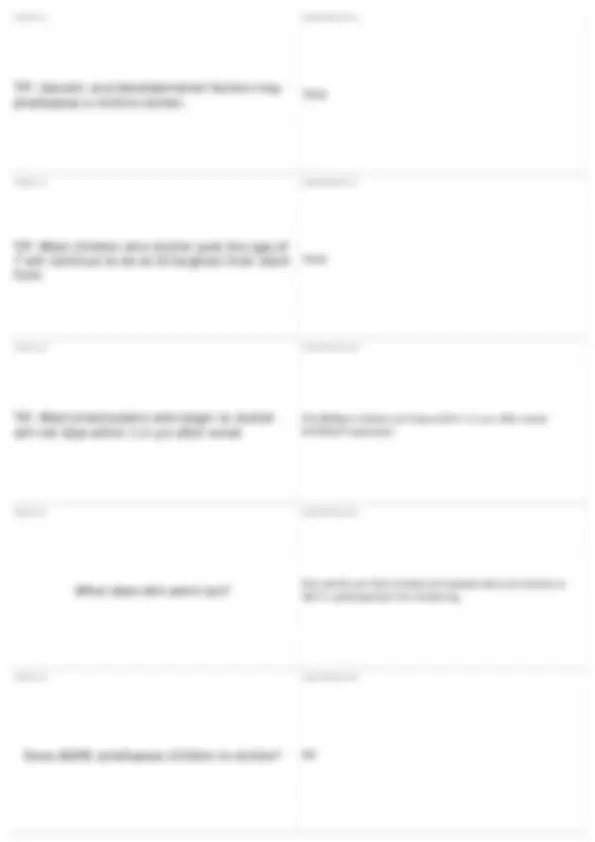
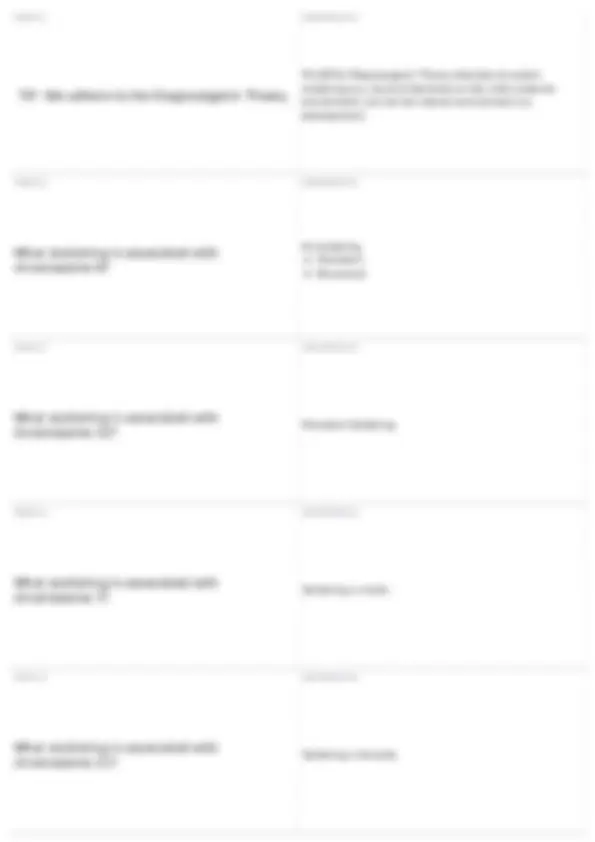
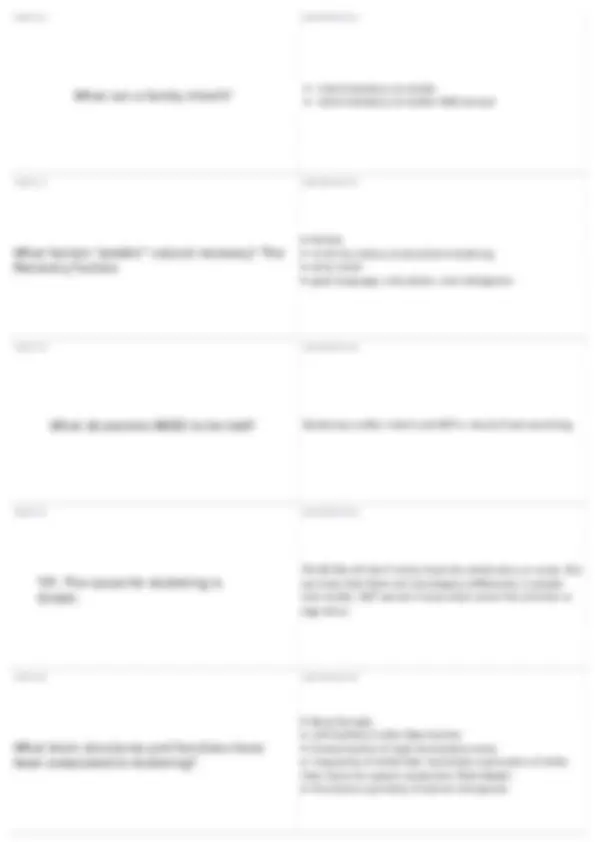
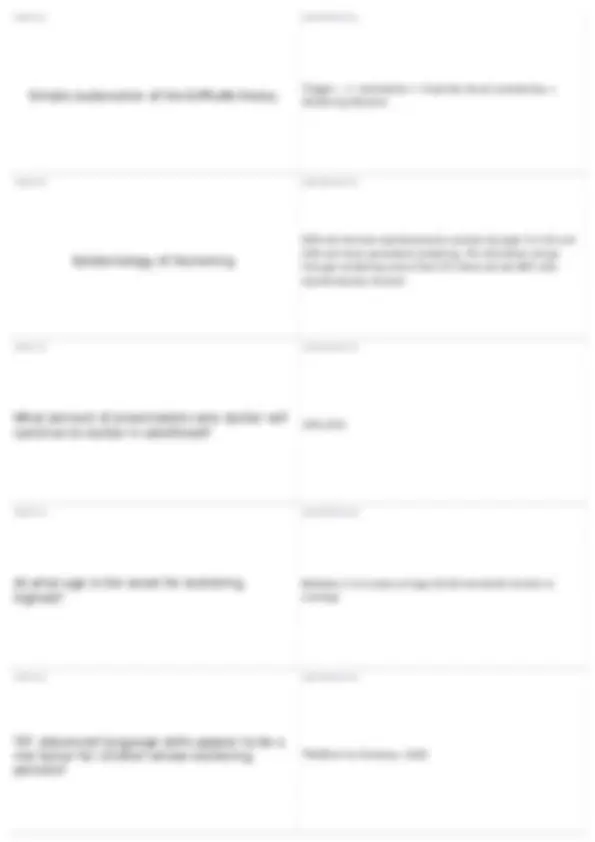
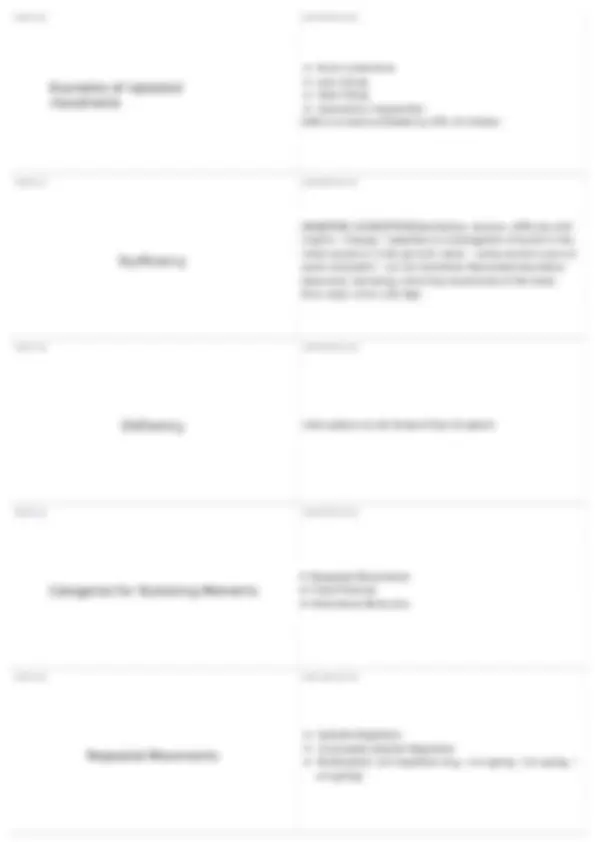
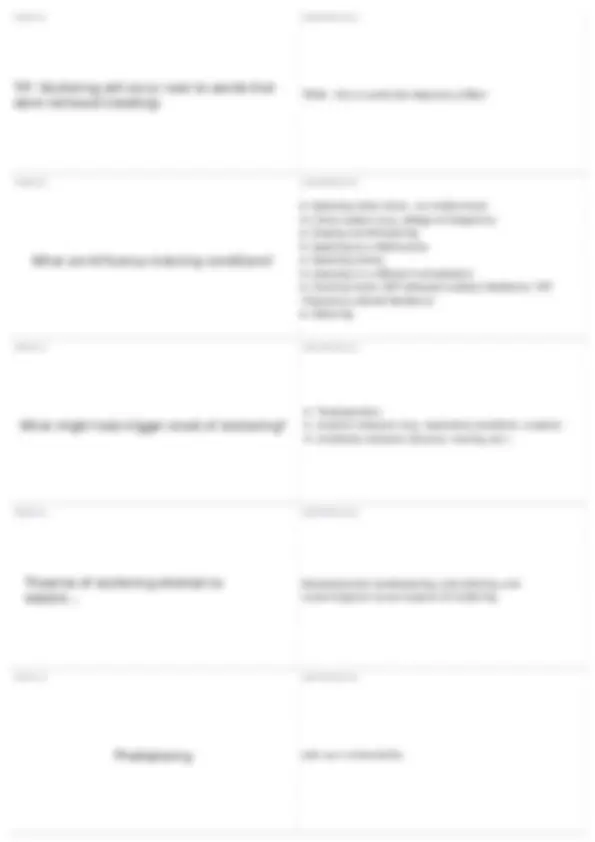
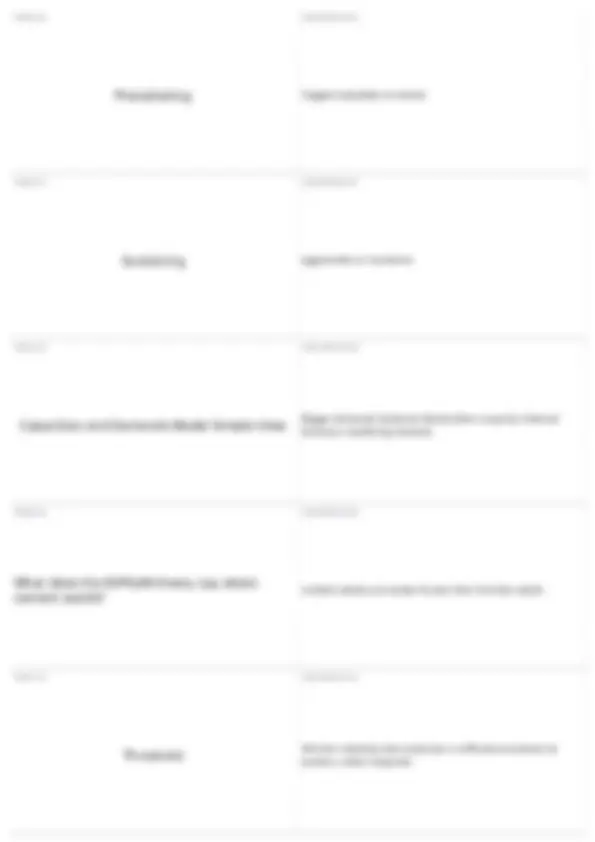
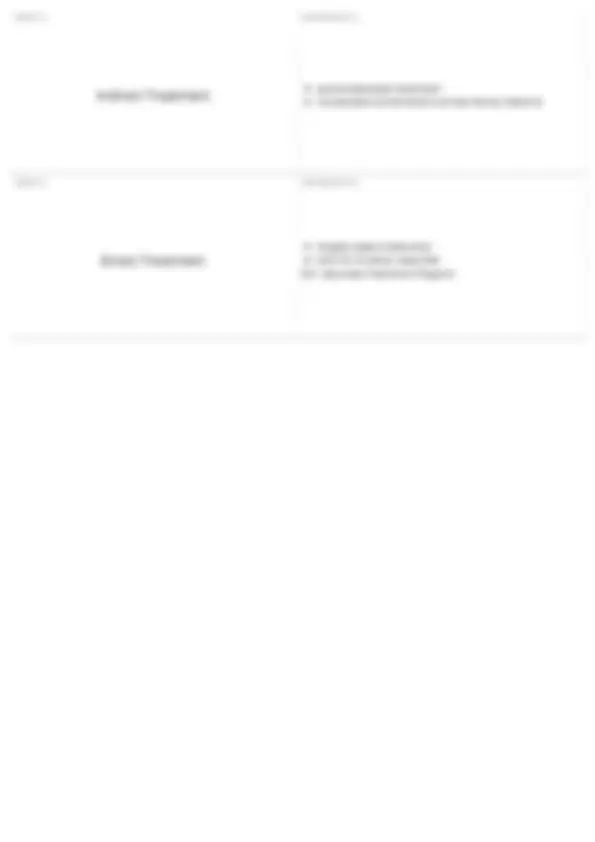


Study with the several resources on Docsity

Earn points by helping other students or get them with a premium plan


Prepare for your exams
Study with the several resources on Docsity

Earn points to download
Earn points by helping other students or get them with a premium plan
Community
Ask the community for help and clear up your study doubts
Discover the best universities in your country according to Docsity users
Free resources
Download our free guides on studying techniques, anxiety management strategies, and thesis advice from Docsity tutors
Class: COMM - Voice & Fluency Disorders; Subject: Communication; University: CUNY Lehman College; Term: Forever 1989;
Typology: Quizzes
1 / 15

This page cannot be seen from the preview
Don't miss anything!










Diagnosogenic Theory (Theory of Causality) Capacities and Demands Model Interhemispheric Interference Model The EXPLAN theory The P&A Model TERM 2
DEFINITION 2 valid exhaustive elegant parsimonious exclusive testable predictive consistent flexible explanatory TERM 3
DEFINITION 3 behavioral diversity the influence of spoken language epidemiology conditions that reduce or eliminate stuttering Stuttering and wind musical instruments Stuttering and nonsense words Stuttering and bimanual tasks Stuttering severity is variable Stuttering and genetics Brain structure and function TERM 4
DEFINITION 4 Why children begin to stutter suddenly how verbal contigent stimulation can control stuttering during early childhood TERM 5
DEFINITION 5 Diagnosogenic Theory
Capacities and Demands Model TERM 7
DEFINITION 7 Behavioral diversity The influence of spoken language Stuttering severity is variable TERM 8
DEFINITION 8 Behavioral Diversity The Influence of spoken language The conditions that reduce or eliminate stuttering Stuttering and genetics Brain structure and function TERM 9
DEFINITION 9 The P&A Model, however, theory is not an end-all. TERM 10
DEFINITION 10 Packman & Attanasio
TERM 17
DEFINITION 17 TRUE TERM 18
DEFINITION 18 FALSEMost children will stop within 1-2 yrs after onset WITHOUT treatment TERM 19
DEFINITION 19 Alm points out that anxiety and people who are anxious is NOT a predisposition for stuttering. TERM 20
DEFINITION 20 NO.
FALSEThe Diagnosogenic Theory attempts to explain stuttering as a result of demands on the child's external environment, but not the internal environment (i.e. development) TERM 22
DEFINITION 22 All stuttering Persistent Recovered TERM 23
DEFINITION 23 Persistent Stuttering TERM 24
DEFINITION 24 Stuttering in males TERM 25
DEFINITION 25 Stuttering in females
Reactions include: Anxiety Avoidance/Escape Speech management skills TERM 32
DEFINITION 32 40% TERM 33
DEFINITION 33 About 69% - it varies by study... but there is a genetic factor. TERM 34
DEFINITION 34 Males TERM 35
DEFINITION 35 It means that there could be a genetic predisposition to stuttering in an individual, but there are other reasons for why individuals develop stuttering just as any medical condition or disorder.
Inherit tendency to stutter inherit tendency to stutter AND recover TERM 37
DEFINITION 37 female no family history of persistent stuttering early onset good language, articulation, and intelligence TERM 38
DEFINITION 38 Stuttering is often inherit and NOT a result of bad parenting. TERM 39
DEFINITION 39 FALSE We still don't really know the whole story or cause. But we know that there are neurological differences in people who stutter. BUT we don't know what came first (chicken or egg story). TERM 40
DEFINITION 40 Basal Ganglia Left Auditory Cortex Deactivation Overactivation of right hemisphere areas Irregularity of white fiber tracts/late myelination of white fiber tracts for speech production (P&A Model) Anomalous symmetry of planum temporale
facial contortions eye closing head tilting respiratory irregularties ONE is at least exhibited by 52% of children TERM 47
DEFINITION 47 ABNORMAL DISRUPTIONShesitations, tension, difficulty with rhythm, "choppy," repetition or prolongation of sound in the initial sound or in the part of a word. - same sound or part of word; tone/pitch - can be monotone Associated secondary behaviors: stamping, clenching movements of the head, face, eyes, arms, and legs. TERM 48
DEFINITION 48 Interruptions to the forward flow of speech TERM 49
DEFINITION 49 Repeated Movements Fixed Postures Extraneous Behaviors TERM 50
DEFINITION 50 Syllable Repetition Incomplete Syllable Repetition Multisyllabic unit repetition (e.g. I am going, I am going, I am going)
refers to mouth and face when making a productiontwo routes: audible and inaudible TERM 52
DEFINITION 52 Prolongation TERM 53
DEFINITION 53 Block - open mouth posture - breath held TERM 54
DEFINITION 54 Two routes: verbal and nonverbalCalls attention to itself.Redundant and not necessary TERM 55
DEFINITION 55 filler words, could be words used as interjection - excessively and interferes with the flow of communication.
TRUE - this is called the Adjacency Effect TERM 62
DEFINITION 62 Speaking when alone...to child/animals Choral speech (e.g. pledge of allegiance) Singing and Whispering Speaking to a Metronome Speaking slowly speaking in a different voice/dialect masking noise, DAF (delayed auditory feedback), FAF (frequency altered feedback) Swearing TERM 63
DEFINITION 63 Predisposition physical stressors (e.g. respiratory problems, surgery) emotional stressors (divorce, moving, etc.) TERM 64
DEFINITION 64 Developmental (predisposing, precipitating, and sustaining)and causal aspects of stuttering TERM 65
DEFINITION 65 sets up a vulnerability
triggers episodes or events TERM 67
DEFINITION 67 aggravates or maintains TERM 68
DEFINITION 68 Bigger demands (external factors)than capacity (internal factors)= stuttering moment TERM 69
DEFINITION 69 content words are harder to plan than function words TERM 70
DEFINITION 70 Minimal intensity that produces a sufficient excitation to evoke a motor response